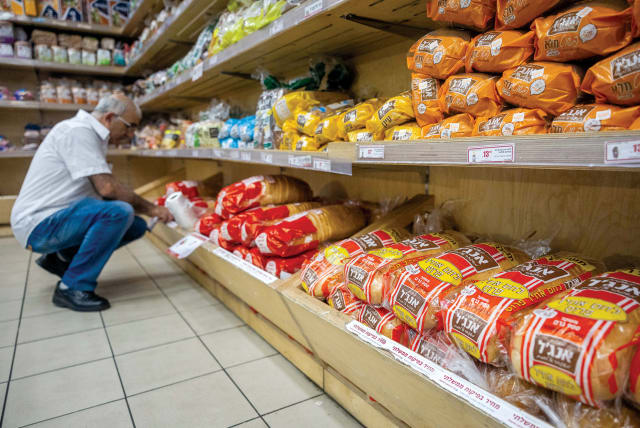More Israelis are poor as gap widens between haves, have-nots

Charitable organizations play a vital role in a country where the cost of living and the gap between rich and poor are large and growing, but experts say a real solution requires government action
At 87 years old, Haim Margolis comes home to an empty refrigerator every evening. When he finishes volunteering at a daycare center for the elderly, he makes sure to take some of the leftover food home to his apartment, where he lives alone. Sometimes he gives food to other needy people.
“I eat so that I won’t die, not so that I live,” said the elderly Holocaust survivor who lives under the poverty line. “My fridge is empty and without donations, I would not have heat or blankets in the winter.”
The extent of poverty in Israel
Margolis isn’t alone. Israelis are consistently getting poorer. Despite the economy which grew in 2021, the gap between the rich and poor also grew wider and more people entered the cycle of poverty, a cycle that is a struggle to break.
According to the Israeli National Insurance Institute’s 2021 report on poverty and social gaps in the country, almost 2 million Israelis live in poverty, a little over 20% of the population. The Organization for Economic Cooperation and Development points to Israel as one of the countries with the highest economic disparity, with the rate of working poor in Israel also very high.
The Gini Index, which measures income inequality, also puts Israel in an undesirable location compared to other developed welfare states. Poverty in Israel can be attributed to many factors. Ultra-Orthodox Jews and the Arab minority tend to have larger families, often earn lower incomes, and have less access to education. Higher-paying jobs are concentrated in central Israel, where it is more expensive to live. Public transportation still needs to be significantly improved, and until then, access to job centers is limited for people who do not own private cars. Salaries in the public sector, one of the largest in the country, tend to be low and have not been updated in years.
Margolis has worked all his life and now volunteers to keep himself busy.
“I’m used to this. I live modestly,” he said. “At the end of the month, I have no money left and I am in debt. I never had much; everything was so difficult.”
Margolis is a widower. His children, fifteen grandchildren, and sixteen great-grandchildren are all struggling to make ends meet and none of them can support him.
The Central Bureau of Statistics data shows many households cannot meet the demands of basic monthly payments for utilities, food, and education. A staggering number of Israelis skip medical treatments and forgo medication to pay for other basics.
Chasdei Naomi is a charity organization working all over Israel.
“As prices get higher, charities have to work harder,” said Tamir Hass, spokesman and public relations manager for Chasdei Naomi. The organization aids 130,000 Israelis with donations, food, and heating supplies.
The new government has promised to lower the cost of living, but the gaps existed long before the global inflation crisis began and the cost of living in the country has been one of the highest in the world for years.
The global pandemic made rich Israelis richer. Government aid to the poor throughout the crisis helped them from further sinking into poverty. The National Insurance Institute has recommended continuing the increase in financial aid to those in need.
With inflation on the rise, more and more Israelis are able to do less with their money, pushing more people into poverty.
“In order to deal with inequality, the state needs to intervene. Either by increasing taxation or raising government allowances,” said Professor John Gal, Welfare Policy Program chair at the Taub Center for Social Policy Studies in Israel and a lecturer in social work and social welfare at the Hebrew University of Jerusalem. “At this point, neither look to be on the horizon.”
According to Latet, an Israeli NGO aimed at combatting poverty and food insecurity, poverty is a “direct result of government policy.” In its poverty report for 2022, it points to the thriving economy and calls on the government to seize “this unique moment … (and) opportunity to finally make massive investments in social expenditure and stop sufficing with partial solutions and lacking budgets.”
The latest government plan to tackle the rising cost of living was revealed last week and consists of measures that will only have a small impact on people’s pockets.
“We need to deeply change Israeli society and make it not just an economic, technological, and military powerhouse, but also a superpower of social justice,” the report read.
“One way to deal with poverty is by creating a list of products at minimum cost. This list needs to be longer than it is today,” said Hass. The current list of price-controlled products is short and does not include fruits and vegetables.
In striking contrast to the grinding poverty suffered by Haim Margolis and 20% of all Israelis, tremendous wealth in Israel is concentrated in a few hundred people. According to Forbes, 77% of the richest 500 people in the country are billionaires. This number jumped in the last decade when they were fewer than half. In the last 20 years, the wealth of these 500 grew tenfold.
“The labor market is very polarized,” Gal explained. “The lower wages are horrifically low, but there is a limit to how much the state can fix through allowances. These gaps need to be closed. If Israel strives for equality, the higher income earners need to pay more tax in order to fund programs but also to distribute income more fairly.”
Many of them made their money from the booming tech sector, which has not contributed to a more even distribution of wealth. Poor people in Israel have less access to education, especially higher education, and they are less likely to live in places with higher than minimum-wage jobs.
But also, rich Israelis own a massive amount of real estate, while most Israelis are either struggling to make their mortgage payments or cannot afford to buy their first home.
Like many poor people, Margolis lives in a government housing project which costs him a symbolic amount. But his income from different government allowances is still not enough.
“Poverty in Israel is larger than in any welfare state,” said Gal. “It needs to be dealt with immediately through a combination of generous allowances and programs that bring more people into the workforce.”
For Margolis, it might be too late. But Gal is optimistic and sees an increasing number of positive indications.
“Israel is still far [from where it should be], but there is progress. Programs are still on the small scale,” he said. “They need to be comprehensive and require a lot of manpower and funding. It is very complex.”
The Labor, Social Affairs, and Social Services Ministry operate several programs aimed at helping populations on welfare be incorporated into the workforce.
“We need to connect disadvantaged populations to accessible education in order to allow social mobility through this education,” said Hass. “This is only just. Right now, we are missing the potential from a lot of young minds that could be brilliant in many fields but are forced to help their families in order to survive.”
Some of the current legislation discourages people on welfare allowances from seeking to improve their education. The National Insurance Institute has also asked to change this, in addition to updating allowances to make them more suitable for the cost-of-living increases.
Many changes need to be made for the large gaps in Israel to close.
Haim Margolis, who receives assistance from several organizations, including Chasdei Naomi, needed their help to heat his home. He maintains a positive outlook on life, despite the hardships he has faced.
“I have found good people along the way,” he said and thanked the charity. “They heat my house in the winter and they warm my heart all year long.”
Jerusalem Post Store
`; document.getElementById("linkPremium").innerHTML = cont; var divWithLink = document.getElementById("premium-link"); if (divWithLink !== null && divWithLink !== 'undefined') { divWithLink.style.border = "solid 1px #cb0f3e"; divWithLink.style.textAlign = "center"; divWithLink.style.marginBottom = "15px"; divWithLink.style.marginTop = "15px"; divWithLink.style.width = "100%"; divWithLink.style.backgroundColor = "#122952"; divWithLink.style.color = "#ffffff"; divWithLink.style.lineHeight = "1.5"; } } (function (v, i) { });


